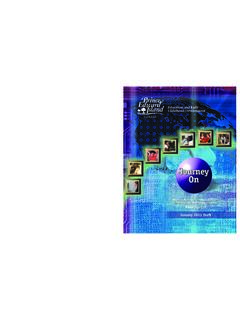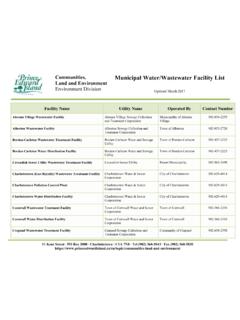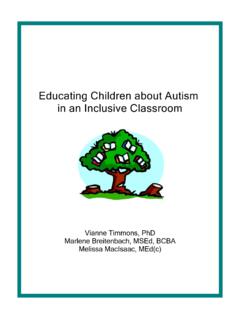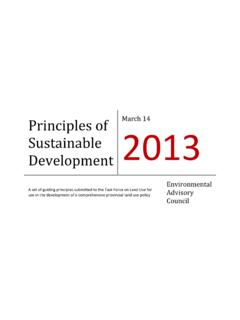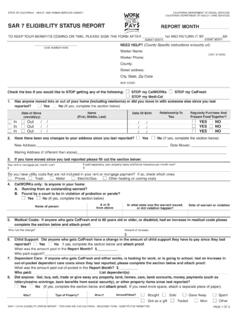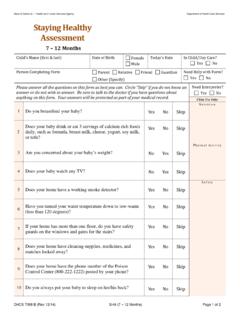Transcription of English Language Arts Grades 7-9 - Prince Edward Island
1 English Language arts 7-9. February 2011. ACKNOWLEDGMENTS. Acknowledgments The Council of Atlantic Ministers of Education and Training (CAMET) and the departments of education of New Brunswick, Newfoundland and Labrador, Nova Scotia, and Prince Edward Island gratefully acknowledge the contribution of the regional English Language arts common curriculum committee to the revised curriculum guide. Committee members include the following: New Brunswick Prince Edward Island Tiffany Bastin Cathy Montgomery Jarmo Puiras Newfoundland and Labrador CAMET. Jill Howlett Sylvie Martin Nova Scotia Barry Wilson The Council of Atlantic Ministers of Education and Training (CAMET) and the departments of education of New Brunswick, Newfoundland and Labrador, Nova Scotia, and Prince Edward Island gratefully acknowledge the following provinces for granting permission to use the resources listed below.
2 British Columbia English Language arts grade 7: Integrated Resource Package (2006), English Language arts grade 8: Integrated Resource Package (2007), English Language arts grade 9: Integrated Resource Package (2007). Used with permission of British Columbia Ministry of Education. Nova Scotia Teaching in Action, Grades 7-9: A Teaching Resource (2007). Adapted with permission from the Province of Nova Scotia Department of Education. Active Readers Grades 7 9 Assessment Resource: Young Adolescents (2005). Adapted with permission from the Province of Nova Scotia Department of Education. Saskatchewan English Language arts 9 (2008). Used with permission of Saskatchewan Ministry of Education.
3 ATLANTIC CANADA English Language arts CURRICULUM Grades 7-9 iii ACKNOWLEDGMENTS. iv ATLANTIC CANADA English Language arts CURRICULUM Grades 7-9. CONTENTS. Contents List of Illustrations xi Introduction to English 7-9 Language arts Background ..3. The Atlantic Cananda English Language arts Curriculum ..3. Essential Graduation Learnings ..4. Connections between Essential Graduation Learnings and Key-Stage Curriculum Outcomes ..4. Purpose of the English 7-9 Curriculum Guide ..7. The Nature of English Language arts ..7. Comprehension and Definition of An Effective English Language arts Zone of Proximal Development ..9. Gradual Release of Responsibility.
4 10. Contexts for Learning and Teaching in English 7-9 ..11. Principles Underlying the English Language arts Curriculum ..11. Considerations for Program Delivery The Learning Environment ..17. Developmental Characteristics of Adolescents ..17. Intellectual Development ..17. Social Development ..18. Physical Development ..18. Emotional and Psychological Development ..19. Moral Development ..19. The Role of the Teacher ..20. Establishing Community in the English Language arts Meeting the Needs of All Students ..22. Valuing Equity and Diversity ..22. Students with Exceptionalities ..24. English as an Additional Language (EAL) Students ..25. Students with Language and Communication Challenges.
5 25. Advanced Learners ..26. Engaging All Students ..26. Student Learning Preferences ..27. Resource-Based Learning ..28. Differentiated Differentiating by Content ..29. Differentiating by Differentiating by Product ..31. Opportunities for Student Choice ..31. Differentiating the Learning Environment ..32. ATLANTIC CANADA English Language arts CURRICULUM Grades 7-9 v CONTENTS. A Framework for Balanced Instruction in English Language 33. Selecting Strategies .. 33. Workshop Approach .. 34. The Speaking and Listening Strand .. 35. Expectations for Speaking and Listening .. 35. The Role of the Teacher .. 36. Organizing the Speaking and Listening Environment.
6 37. Organizing for Speaking and Listening Instruction .. 37. Speaking .. 38. Listening .. 39. Focuses for the Strand .. 40. The Reading and Viewing Strand .. 42. Expectations for Reading and Viewing .. 42. The Role of the Teacher .. 43. Organizing the Reading and Viewing Environment .. 44. Organizing for Reading and Viewing Instruction .. 44. Varying the Reading and Viewing Experience .. 47. Reading Workshop .. 48. Stages of Reading Development .. 48. Reading Strategies .. 49. Focuses for the Strand .. 51. The Writing and Representing Strand .. 53. Expectations for Writing and Representing .. 53. The Role of the Teacher .. 53. Organizing for Writing and Representing Instruction.
7 54. Writing Workshop .. 55. Focus Lessons .. 56. Expressive or Exploratory Writing .. 56. Transactional Writing .. 57. Poetic Writing .. 57. Determining Purpose .. 58. Determining Audience .. 58. Determining Form .. 58. Text Forms .. 59. Representing .. 61. Focuses for the Strand .. 63. Organizing Learning Experiences for Students .. 65. The Workshop: A Framework for 65. Time to Teach .. 66. Time to Practise and 67. Time to Share and Reflect .. 69. Integrated Teaching and Learning .. 72. Inquiry-Based Learning .. 72. vi ATLANTIC CANADA English Language arts CURRICULUM Grades 7-9. CONTENTS. Content Elements ..73. Literacy Learning ..73. Developing Multiple Media Literacy.
8 74. Media Awareness ..75. Critical Literacy ..76. Visual Literacy ..77. Information Literacy ..78. Areas of Text Inquiry in English 7-9 ..79. Understanding Responding to Texts ..81. Personal Responses ..82. Critical Responses ..83. The Role of Literature ..84. Literary Genres ..85. Responding to Poetry ..89. Drama ..89. Readers Reader's Notebook ..91. Online Interaction ..91. Essays ..91. Research as Inquiry ..91. The Role of the Teacher ..92. Sharing Learning Stages of Inquiry ..95. Planning ..95. Gathering Interacting with Information ..96. Synthesizing Information ..97. Assessment and The Processes of Writing ..100. Inquiry Strategies for Writing.
9 102. Prewriting ..102. Drafting Strategies for Writing ..102. Organizing ..102. Drafting ..102. Product Strategies for Writing ..103. Revising ..103. Publishing ..104. Conferring with Students ..105. Content Conferences ..105. Editing Conference Prompts ..107. ATLANTIC CANADA English Language arts CURRICULUM Grades 7-9 vii CONTENTS. Assessing and Evaluating Student Achievement Introduction ..111. Assessment ..111. Purposes of Assessment ..112. Assessment for Learning ..112. Assessment as Learning ..113. Assessment of Designing Effective Assessments ..114. The Role of the Teacher ..117. Providing Feedback to Students ..119. Assessment Planning Summary.
10 120. Involving Students in the Assessment Process ..122. Assessment Tools ..122. Portfolios ..125. Tests and Examinations ..125. Understanding the Student Achievement Standards ..126. Application of the Standards ..126. Planning for Individual Instruction ..126. Assessing Speaking and Listening ..127. Assessing Reading and Assessing Writing and Representing ..136. Using Traits of Writing Appropriate Indicators of Achievement ..138. Assessing Students' Responses to Text ..139. Curriculum Outcomes Introduction .. 145. General Curriculum Outcomes (GCOs) .. 145. Key-Stage Curriculum Outcomes .. 146. Specific Curriculum Outcomes (SCOs) .. 151. Speaking and Listening 151.


